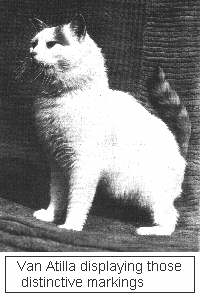The Turkish Van (and Vankedisi) is a naturally occurring semi long
haired breed from the rugged region of the Middle East centred on Lake
Van, were the climate varies to extremes. The breed is known for its
distinctive pattern, a white cat with a strikingly coloured head and
tail. The "top-and-tail" markings, even when seen on other breeds of
cat, are frequently referred to as "van patterning".
 The Van region is surrounded by mountains and its high plateau is subject
to extreme changes in temperature. The breed does not have an undercoat,
but with snow lasting at least six months of year in that area, the silky
coat became thicker and longer as required and also somewhat waterproof
with feathering on the ears and tufts on the feet. However, when the exceptional
heat of summer arrived, the extra coat would be quickly shed. This is
replicated in cats in this country, to a slightly lesser degree.
The Van region is surrounded by mountains and its high plateau is subject
to extreme changes in temperature. The breed does not have an undercoat,
but with snow lasting at least six months of year in that area, the silky
coat became thicker and longer as required and also somewhat waterproof
with feathering on the ears and tufts on the feet. However, when the exceptional
heat of summer arrived, the extra coat would be quickly shed. This is
replicated in cats in this country, to a slightly lesser degree.
It is a large, muscular cat; the strength and power is evident in the
substantial body and legs. The breed does not gain full maturity until
three years or more. Individual cats should convey an impression of a
well balanced, well proportioned and strong appearance in which no one
feature is exaggerated. The weight should be appropriate for the bone
structure and frame. The feet are neat, well rounded and tufted.
The head forms a substantial broad wedge with a medium to long straight
nose, with barely perceptible dip in profile. The ears are moderately
large and well feathered, whilst the eyes are large and oval, always alert
and expressive, and having pink rims.
Ideally the body should be chalk white with no trace of yellow. The Van Cat
should have coloured markings on the head, but not below the level of the
eyeliners or beyond the base of the rear of the ears, with the colour
on the head separated by a vertical white blaze. The tail should also
be coloured. Small "thumb prints" of colour irregularly placed on the
cat are acceptable for show standard, as is colour extending from the
root of the tail onto the back. The Turkish Vankedisi is, of course, pure white.
The Turkish Van has a full brush, with
a length to balance with the body.
The fur should be long soft and silky to the roots. The coat is noticeably
shorter in the summer; in the winter it is much thicker, as it had to
provide protection against the freezing winters of their homeland. The
neck and chest ruff become even more pronounced with maturity.
From June 2000, the Turkish Van was recognised by the GCCF for Championship Status
in White with Auburn, Cream, Black, Blue, Tortoiseshell, Blue Tortie,
Brown Tabby, Blue Tabby, Tortie Tabby or Blue Tortie Tabby, and with three
different eye colours - these being amber, blue or one of either colour.
In February 2005 the Turkish Vankedisi was granted Preliminary Recognition by the GCCF.
|



